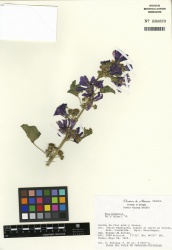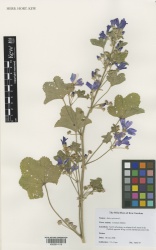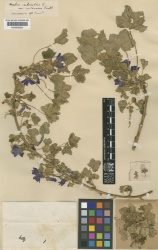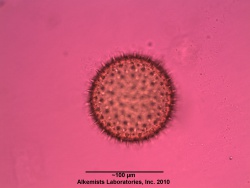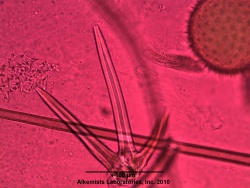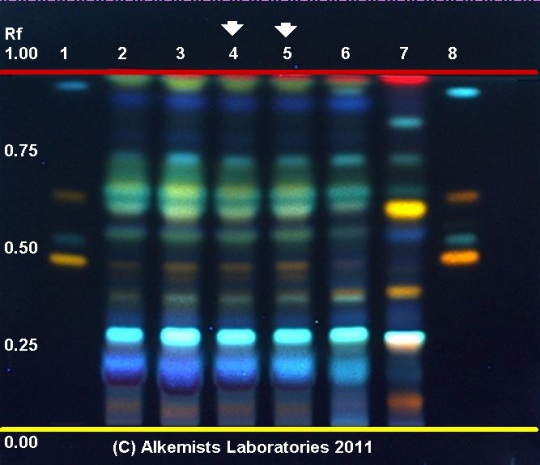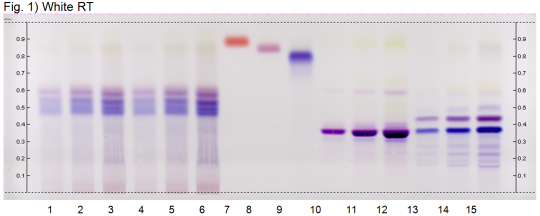Malva sylvestris (flower)
(→alphabetize HPTLC entries) |
(add Culbreth ref for organoleptic, macro) |
||
| (9 intermediate revisions by 2 users not shown) | |||
| Line 1: | Line 1: | ||
| − | = | + | {{DISPLAYTITLE:''Malva sylvestris'' (flower)}} {{askbox|herb=''Malva sylvestris''}} |
| − | =Macroscopic | + | =Nomenclature= |
| − | =Microscopic | + | |
| − | {{Microscopy | source=Elan M. Sudberg, Alkemist Laboratories | + | =Botanical Voucher Specimen= |
| + | |||
| + | {{Media3 |cat=Voucher | ||
| + | |||
| + | | source=MOBOT, Tropicos.org | ||
| + | | mainimage=Malva_sylvestris_Tropicos_100000537.jpg | ||
| + | | companyimage=TropicosLogo.gif | ||
| + | | companyURL=http://www.tropicos.org/Image/100000537 | ||
| + | | reference=Tropicos.org. Missouri Botanical Garden. 26 Mar 2014 <http://www.tropicos.org/Image/100000537> | ||
| + | |||
| + | | companyimage2=Kewlogo.gif | ||
| + | | companyURL2=http://specimens.kew.org/herbarium/K000914119 | ||
| + | | image2=Malva sylvestris Kew barcode=K000914119 479685.jpg | ||
| + | | source2=Royal Botanic Gardens, Kew. | ||
| + | |||
| + | | companyimage3=Kewlogo.gif | ||
| + | | companyURL3=http://specimens.kew.org/herbarium/K000659331 | ||
| + | | image3=Malva sylvestris L. var. violascens Kew barcode=K000659331 284874.jpg | ||
| + | |caption3=''Malva sylvestris'' L. var. ''violascens'' | ||
| + | | source3=Royal Botanic Gardens, Kew. | ||
| + | |||
| + | | }} | ||
| + | |||
| + | =Organoleptic Characteristics= | ||
| + | {| border=1 | ||
| + | | | ||
| + | {{Organolepsy | source=Culbreth, D. (1917) A Manual of Materia Media and Pharmacology, 6th ed. | ||
| + | | description=Slight odor; sweetish, mucilaginous taste.}} | ||
| + | |} | ||
| + | =Macroscopic Characteristics= | ||
| + | {| border=1 | ||
| + | | | ||
| + | {{Macroscopy | source=Culbreth, D. (1917) A Manual of Materia Media and Pharmacology, 6th ed. | ||
| + | | description=The flowers are rose-red, purple, or whitish, but when dried bluish, green with ammonia, red with acids. | ||
| + | }} | ||
| + | |} | ||
| + | |||
| + | =Microscopic Characteristics= | ||
| + | {| border=1 | ||
| + | | | ||
| + | |||
| + | {{Microscopy | source= Elan M. Sudberg, Alkemist Laboratories | ||
| companyimage= AP-LOGO-Laboratories Crop - Copy.jpg | | companyimage= AP-LOGO-Laboratories Crop - Copy.jpg | ||
| − | | companyURL=http://www. | + | | companyURL= http://www.alkemist.com |
| − | + | | description= Cellular structures identified in this botanical specimen are spherical pollen grains, about 150 μm in diameter, with a roughly spiny exine and the thick walled stellate trichomes when observed at 400x with Acidified Chloral Hydrate Glycerol Solution. | |
| − | + | ||
| − | + | ||
| − | + | ||
| − | + | ||
| − | + | ||
| reference=British Pharmacopoeia, 2003 | | reference=British Pharmacopoeia, 2003 | ||
| }} | | }} | ||
| − | = | + | {{Media2 |cat=Microscopy |companyimage= AP-LOGO-Laboratories Crop - Copy.jpg |
| + | | companyURL= http://www.alkemist.com | ||
| + | |companyimage2= AP-LOGO-Laboratories Crop - Copy.jpg | ||
| + | | companyURL2= http://www.alkemist.com | ||
| + | |mainimage= Blue_Mallow_Flower_Alkemist_Laboratories.jpg | ||
| + | |caption1=Spherical pollen grains, about 150 μm in diameter, with a roughly spiny exine observed at 400x with Acidified Chloral Hydrate Glycerol Solution. | ||
| + | |source= Elan M. Sudberg, Alkemist Laboratories | ||
| + | |image2= Blue_Mallow_Flower-1_Alkemist_Laboratories.jpg | ||
| + | |caption2=Thick walled stellate trichomes observed at 400x with Acidified Chloral Hydrate Glycerol Solution. | ||
| + | |source2= Elan M. Sudberg, Alkemist Laboratories }} | ||
| + | |} | ||
| + | =High Performance Thin Layer Chromatographic Identification= | ||
{{HPTLC | source=Elan M. Sudberg, Alkemist Laboratories | {{HPTLC | source=Elan M. Sudberg, Alkemist Laboratories | ||
| description=High Mallow (flower) (''Malva sylvestris'') | | description=High Mallow (flower) (''Malva sylvestris'') | ||
| Line 39: | Line 86: | ||
| reference=Adapted from British Pharmacopoeia, 2003 | | reference=Adapted from British Pharmacopoeia, 2003 | ||
| }} | | }} | ||
| + | |||
{{HPTLC | source=HPTLC Association | {{HPTLC | source=HPTLC Association | ||
| Line 79: | Line 127: | ||
Test for other species: No intense violet-blue zones are seen between Rf ~ 0.46 and 0.55 (Bilberry fruit) and no violet zone is present at Rf ~ 0.44 (Roselle flower). | Test for other species: No intense violet-blue zones are seen between Rf ~ 0.46 and 0.55 (Bilberry fruit) and no violet zone is present at Rf ~ 0.44 (Roselle flower). | ||
| }} | | }} | ||
| − | = | + | =Supplementary Information= |
| − | [[Category: | + | |
| + | =Sources= | ||
| + | |||
| + | <references /> | ||
| + | [[Category:Botanical]] | ||
Latest revision as of 15:44, 7 July 2015
Contents |
Nomenclature
Botanical Voucher Specimen
 |
 |
|
|
|
|
|
Organoleptic Characteristics
|
Macroscopic Characteristics
|
Microscopic Characteristics
|
High Performance Thin Layer Chromatographic Identification
|
High Mallow (flower) (Malva sylvestris) Lane Assignments Lanes, from left to right (Track, Volume, Sample):
Reference materials used here have been authenticated by macroscopic, microscopic &/or TLC studies according to the reference source cited below held at Alkemists Pharmaceuticals, Costa Mesa, CA. Stationary Phase Silica gel 60, F254, 10 x 10 cm HPTLC plates Mobile Phase ethyl acetate: HCOOH: AcCOOH: H2O [10/1.1/1.1/2.4] Sample Preparation Method 0.3 g + 3 ml 70% grain EtOH sonicate/heat @ 50° C ~ 1/2 hr Detection Method Natural Product Reagent + PEG -> UV 365 nm Reference see Adapted from British Pharmacopoeia, 2003
|
|
Mallow (flower) (Malva sylvestris) Lane Assignments Lanes, from left to right (Track, Volume, Sample):
Reference Sample(s) Reference: Dissolve 2 mg of pelargonin in 5 mL of methanol. Dissolve 2 mg of delphinidin in 5 mL of methanol; Optional: dissolve 2 mg of malvidin in 5 mL of methanol. Stationary Phase Stationary phase, i.e. Silica gel 60, F254 Mobile Phase 1-Butanol, formic acid, water 65:16:19 (v/v/v) Sample Preparation Method Sample: Mix 1 g of powdered sample with 10 mL of methanol and sonicate for 10 minutes, then centrifuge or filter the solutions and use the supernatants / filtrates as test solutions. Detection Method Saturated chamber; developing distance 70 mm from lower edge; relative humidity 33% Other Notes Images presented in this entry are examples and are not intended to be used as basis for setting specifications for quality control purposes. System suitability test: Pelargonin: red to orange zone at Rf ~ 0.89; Delphinidin: violet zone at Rf ~ 0.80 Identification: Compare result with reference images. The fingerprint of the test solution is similar to that of the corresponding botanical reference sample. Additional weak zones may be present. The chromatogram of the test solution shows one intensive violet zone at Rf ~ 0.35. Test for other species: No intense violet-blue zones are seen between Rf ~ 0.46 and 0.55 (Bilberry fruit) and no violet zone is present at Rf ~ 0.44 (Roselle flower).
|
Supplementary Information
Sources
- ↑ MOBOT, Tropicos.org http://www.tropicos.org/Image/100000537
- ↑ Royal Botanic Gardens, Kew. http://specimens.kew.org/herbarium/K000914119
- ↑ Royal Botanic Gardens, Kew. http://specimens.kew.org/herbarium/K000659331
- ↑ Culbreth, D. (1917) A Manual of Materia Media and Pharmacology, 6th ed.
- ↑ Culbreth, D. (1917) A Manual of Materia Media and Pharmacology, 6th ed.
- ↑ Elan M. Sudberg, Alkemist Laboratories http://www.alkemist.com
- ↑ Elan M. Sudberg, Alkemist Laboratories http://www.alkemist.com
- ↑ Elan M. Sudberg, Alkemist Laboratories http://www.alkemist.com
- ↑ Elan M. Sudberg, Alkemist Laboratories http://www.alkemist.com
- ↑ HPTLC Association http://www.hptlc-association.org/
